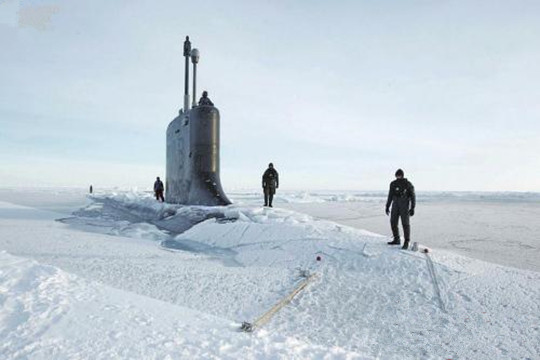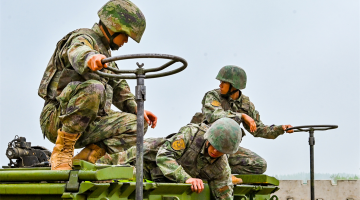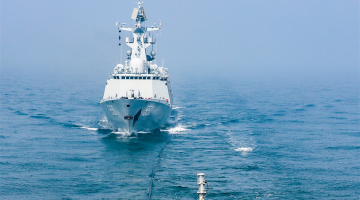
By Li Zhixin
Starting next year, Russia will require foreign military ships traveling through Russian Arctic sea route to give prior notification to relevant department of the Russian government, said Colonel General Mikhail Mizintsev, head of the National Defense Control Center of Russia’s Defense Ministry, on November 30, 2018.
Back in October, Russia deployed its first Tor-M2DT anti-aircraft missile battalion suitable for the Arctic region. The Tor-M2DT air defense missile system is especially designed to be used for climatic and topographical conditions of the Arctic, which has an impressive cross-country ability and can operate at temperatures down to minus 50 degrees Celsius.
The same month, the USS Harry S. Truman entered the Arctic Circle, becoming the first US Navy aircraft carrier to do so since 1991. It then reached Norway to join the NATO exercise Trident Juncture. This exercise was the largest military drill carried out by the NATO after the end of the Cold War, thus generating a strong deterrence effect.
The Arctic is becoming a “new battlefield” for strategic wrestling among Arctic countries, near-Arctic states, and major Arctic stakeholders. Those countries’ strategic competitions for Arctic resources and military security are increasingly escalating.
The Arctic is rich in strategic resources. The US Geological Survey has estimated that areas north of the Arctic Circle have 90 billion barrels of proven, technically recoverable oil, accounting for 13% of the world’s total unproven oil reserves, 1,669 trillion cubic meters of natural gas, accounting for 30% of the world’s total unproven natural gas reserves, and 44.1 billion barrels of liquefied natural gas (LNG), accounting for 20% of the world’s total unproven LNG.
In terms of geographical location, the Arctic has great military and strategic importance. Due to its high latitudes and unblocked view, the region has a special value for strategic precaution. Theoretically, the distance from the Arctic to any point on the North Hemisphere is the shortest. Considering the strike capacity of current states with nuclear weapons, a missile launched from the Arctic Ocean can almost reach any place on the North Hemisphere, thus creating a very strong military deterrence.
In the eyes of many countries, the ice-melting trend of the Arctic and the development of modern weapons just present a good opportunity for them to reinforce their military presence in the region.
On one hand, any country controlling Arctic waterways can concentrate and deploy naval troops quickly to a designated place on the sea via those waterways; on the other hand, the Arctic Ocean is covered by ice and snow all year round, and its thick ice provides natural shelter for military weapons including strategic nuclear submarines.
For these reasons, many countries have strengthened their efforts to contend for control of the Arctic. Because of their geopolitical advantages, the eight countries around the Arctic become the main “players” in the strategic games. Competitions for interests and rights in the Arctic have resulted in an escalating militarization of the region.
As two major players in the geopolitical games in the Arctic, Russia and the United States have always been the leading forces that determine the direction of state-to-state relations in the region. In the past more than two decades, despite occasional conflicts, the two countries meticulously maintained a peaceful situation on the surface until the outbreak of the Ukraine crisis that broke the fragile balance between them. As the Trump administration’s energy policy becomes increasingly clear, the possibility that Russia and the United States may fall into conflicts in the Arctic continues growing.
Besides Russia and the United States, Canada is also a major power in the Arctic. Although it generally shows a “mild” attitude towards international affairs, Canada has always firmly defended its interests in issues concerning the Arctic region.
Since 2001, the Canadian army has begun patrolling the region and built two military bases there. In 2007, Canada announced the establishment of an Arctic legion to protect its sovereignty of territorial waters and islands in the region.
In June 2017, the Canadian government unveiled a new national defense policy report. The report indicated that Canada’s Department of National Defense would enhance its armed forces’ maneuverability and range of projection in the Arctic, invest more funds to enhance its special operations capacity, and expand its air defense identification zone. Moreover, Canada would collaborate with the United States to develop new technologies for improving monitoring and control of the Arctic and carry out joint military exercises with its Arctic allies and partners, with an aim to reinforce Arctic-related prediction capacity and information sharing.
While major countries are actively contending for control of the Arctic, other five Arctic states have never ceased their conflicts of interests in the region. In 2009, Denmark announced to establish the Joint Arctic Command and set up the Thule air force base on Greenland and an Arctic rapid reaction force. Then, Norway moved its military headquarters within the Arctic Circle and purchased F-35 fighters from the United States to reinforce its military deployment in the Arctic.
Located on the shore of the Arctic Ocean, Denmark has long considered the Arctic an important region in its national strategy. In 2011, it issued the Kingdom of Denmark Strategy for the Arctic 2011–2020. In 2016, Denmark’s foreign ministry and national defense ministry unveiled the Danish Defense and Diplomacy in Times of Change and the Future of the Ministry of Defense Mission in the Arctic, respectively, which clarified Denmark’s status as an “Arctic superpower” and put forward the defense plan to strengthen its military deployment on Greenland.
Denmark, Norway, and Sweden are planning to forge a joint rapid reaction force comprised of the navies and air forces of the three countries to monitor and deter other countries’ operations in the Arctic region.
In addition, NATO members including Denmark, Norway, Britain, Finland, and Sweden hold the Loyal Arrow military exercise every year to get ready for intervening into potential Arctic conflicts. Britain even sent its aircraft carrier equipped with nuclear weapons to attend the exercise.
In recent years, increasing numbers of non-Arctic nations and international organizations have set sight on the Arctic and gradually enhanced their political and economic presence in the region, with an aim to garner benefits in the competitions for Arctic interests. Japan and the Republic of Korea (ROK) are the representatives of non-Arctic countries keen on seeking interests in the region.
The ROK isn’t on the coast of the Arctic Ocean. Given its small economic size and lack of natural resources, the ROK has various interest appeals in the Arctic. In this context, it keeps a close eye on changes in the region. The ROK’s operations in the polar regions began with its joining in the Antarctic Treaty in November 1986, and until the early 21st century has the country formulated its own Arctic strategy.
The European Union also attaches great importance to the development of the Arctic. Its main interest appeals for the Arctic involve shipping, energy, mineral resources, and the environment. It is noteworthy that such countries as India, Germany, and Singapore also take an active part in Arctic affairs.
With the increase of the Arctic’s strategic value, international political and economic forces are falling into complex conflicts and fierce competitions for interests in the Arctic. The multi-polarization trend of the Greater Arctic region is becoming increasingly evident.
Disclaimer: The author is Li Zhixin is from the College of Politics of the National Defense University of the PLA. The article was published on the China Youth Daily and translated from Chinese into English and edited by the China Military online. The information, ideas or opinions appearing in this article are those of the author and do not reflect the views of eng.chinamil.com.cn. Chinamil.com.cn does not assume any responsibility or liability for the same. If the article carries photographs or images, we do not vouch for their authenticity.









